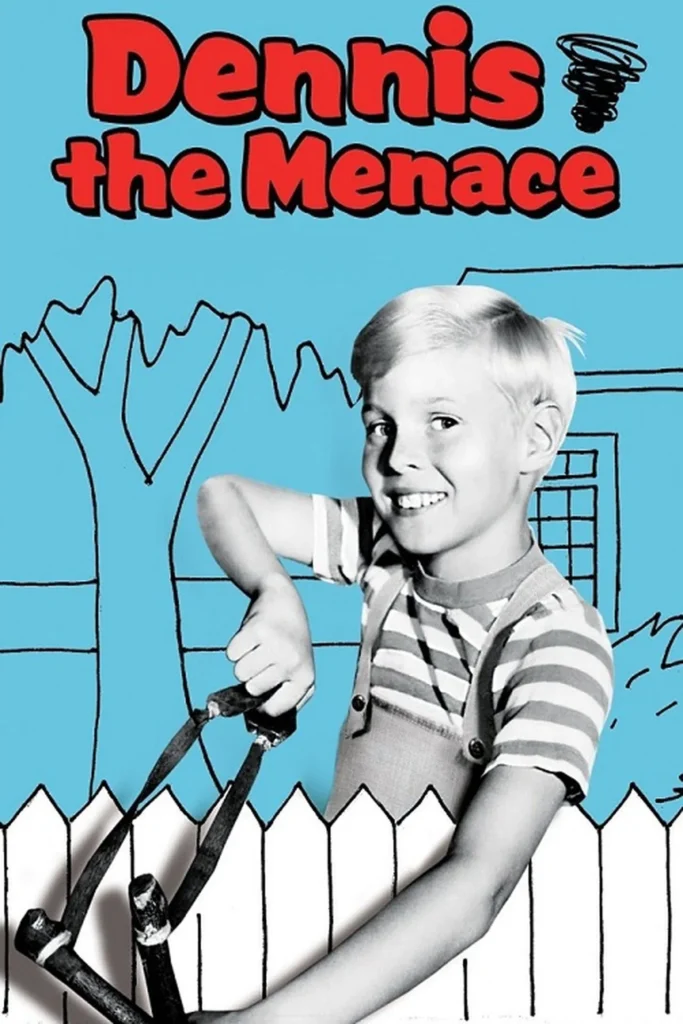
CBS’s Dennis the Menace brought Hank Ketcham’s mischievous comic-strip boy to life in a four-season sitcom (October 1959–July 1963). Produced by Dariell Productions/Screen Gems and sponsored by Kellogg’s and Best Foods, it filled the Sunday 7:30 pm slot (after Lassie). The pilot (“Dennis Goes to the Movies”, filmed 1958) was commissioned as a replacement for Leave It to Beaver. Early on, CBS even instructed writers to temper Dennis’s antics so kids wouldn’t imitate him. In production, tragedy struck when Joseph Kearns (George Wilson) died after 100 episodes (1962). The show handled it by introducing Gale Gordon as Kearns’s character’s brother John Wilson (and wife Sara Seegar as Eloise) in Season 4. By 1963 Jay North (Dennis) was nearly 12 and “outgrowing” the role, so CBS quietly canceled the series
Plot and Characters
In each episode, little Dennis Mitchell is a “good, well-intentioned boy” whose boundless energy and curiosity inevitably lead to comic chaos. Dennis (Jay North) is five years old, tow-headed and always in overalls (and often a slingshot) – proud of his innocent schemes. The show “follows the Mitchell family – Henry, Alice and their only child, Dennis”, but most plots revolve around Dennis tangling with his cranky neighbor, Mr. George Wilson (Joseph Kearns). Mr. Wilson is a retired salesman who “loves peace and quiet” but somehow ends up the target of Dennis’s well-meaning but disruptive help. In one classic episode still, Dennis greets the day with a grin by the neighborhood fence, confidently poised for mischief【65†】. The sitcom establishes that Mr. Wilson actually cares for Dennis – Wilson may fume at the noise, but he’s “proud that Dennis considers him his best friend”
Dennis’s parents, Henry (engineer Herbert Anderson) and Alice (Gloria Henry), are the archetypal patient but exasperated 1950s mom-and-dad. In fact, one reviewer quipped that “the parents of such a child could rightly apply for sainthood” for their patience. Episodes often show Alice or Henry apologizing to a frazzled Mr. Wilson after Dennis’s latest caper, highlighting the family’s warmth and good intentions. The supporting cast includes Dennis’s kid friends – Tommy Anderson (Billy Booth) is Dennis’s best pal, and Margaret Wade (Jeannie Russell) is a neighborhood girl who dotes on Dennis (and whom Dennis humorously dubs “dumb ol’ Margaret”). When Kearns passed, the Wilson household changed: George’s brother John Wilson (Gale Gordon) moves in, along with John’s wife Eloise (Sara Seegar). This created a slightly different dynamic – John is more genial but just as exasperated – yet it still centers on Dennis’s antics. Overall, the plots are simple: Dennis’s innocent attempts to help often make things worse, teaching gentle family lessons without real malice
Cast Performances
The cast is uniformly solid. Jay North is the heart of the show: a charismatic child actor who portrays Dennis’s blend of sweetness and impishness. Modern reviewers praise North’s performance as the key strength. For example, one DVD-era critic calls Dennis “perfectly drawn” and lauds North’s “intensely funny, insistent turn as the well-intentioned but mischievous devil, Dennis.”. North’s timing – rapid-fire questions and dramatic eye-rolls – sells the comedy even today. Joseph Kearns is equally memorable as George Wilson: the perpetually irate neighbor whose gruff voice and deadpan reactions give the show its comic counterpoint. (After Kearns’s death the seasoned character actor Gale Gordon stepped in; though screen historians note the energy shifted, Gordon ably carried on as John Wilson.) The parents, Herbert Anderson and Gloria Henry, play their roles straight – calm exasperation and warm smiles – and provide a stable center. Even the recurring child actors (like Billy Booth as Tommy and Jeannie Russell as Margaret) contribute to the wholesome ensemble.
Cinematography and Direction Style
Dennis the Menace is shot in crisp black-and-white, with a straightforward visual style typical of late-’50s sitcoms. The multi-camera setups are simple, keeping the focus on the actors’ faces and slapstick rather than flashy camerawork. Critics have noted that the show is “beautifully written and constructed”, with “witty scripting and inventive direction”. In practice this means tight, stagey scenes where a single reaction shot or well-timed pause earns a laugh. The direction emphasizes Dennis’s perspective – often low-angle shots or close-ups highlight his mischievous grin (as in many opening scenes). At the same time, the suburban set (the Mitchell and Wilson front yards) evokes a classic family sitcom era. While not visually bold by modern standards, the show’s neat framing and pacing let the comedy land cleanly.
Reception and Ratings
At the time, Dennis the Menace was a ratings hit. It debuted at #16 in the 1959–60 season and rose to #11 in 1960–61, thanks in part to its popular timeslot. (By Season 4 it slipped out of the top 30 as children’s tastes changed.) Today it doesn’t have a critics’ score on Rotten Tomatoes (older TV series often lack Tomatometer listings), but fan ratings remain solid: IMDb users give it around 7.0/10. Modern retrospectives tend to be positive but realistic. For example, DVD reviewer Paul Mavis calls Season 1 “delightfully fun” and praises the show’s “witty scripting” and “perfectly drawn performances”. In particular he highlights Jay North’s energy and the show’s consistent humor. By contrast, some nostalgia writers note that by contemporary standards the humor is very gentle. One critic found the series “sweeter, gentler, blander, and less funny than I recalled,” noting it’s a “straight sitcom-generic, second-tier” comedy that emphasizes warmth and morals over edgy jokes. In sum, reviews agree it’s a charming family comedy – not high-brow – whose strengths are its timeless premise and the actors’ likability, even if some gags feel dated.
Popularity, Syndication, and Cultural Impact
Dennis the Menace became a fixture of American TV culture. It’s widely syndicated: after its original run NBC aired Saturday reruns (1963–65), and it entered syndication in 1965. It found new generations via cable: Nickelodeon aired it (1985–94) and TV Land did later (2002–03). In 2011 it even resurfaced on the classic-TV channel Antenna TV. All four seasons were released on DVD by Shout! Factory (2011–2012), indicating continued fan demand. Internationally, the show aired in the UK (interestingly under the title Just Dennis to avoid confusion with Britain’s own Dennis), and it became one of the best-known American family sitcoms of its era worldwide. The character of Dennis – mischievous yet kindhearted – entered the broader pop-cultural lexicon: he was used in advertising (notably by Dairy Queen for years) and inspired two big-screen films decades later. For fans of 1950s–60s television, Dennis the Menace remains emblematic of its genre: its catchphrases (“Good ol’ Mr. Wilson!”), wholesome humor, and suburban setting evoke nostalgia for a bygone TV age.
Conclusion
A product of its time, Dennis the Menace is heartwarming, if quaint. Its appeal lies in the chemistry between Jay North’s innocent menace and Joseph Kearns’s exasperated neighbor, and in its family-friendly, moral-center stories. While modern viewers may find its plots predictable and humor mild, the series’s strong cast and consistent good-natured tone give it lasting charm. Historically, it’s an important early example of a comic-strip sitcom with wide popularity. Fans of vintage TV will appreciate its brisk pacing and nostalgic comfort. Overall, Dennis the Menace delivers reliable wholesome fun – earning it a solid 8/10 in the pantheon of classic family sitcoms.
Rating: 8/10
